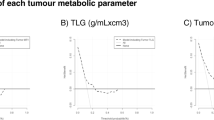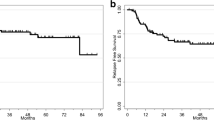Abstract
Purpose
We sought to identify prognostic factors—including positron emission tomography (PET) parameters—in patients with previously untreated squamous carcinoma of the uterine cervix and MRI- or CT-defined pelvic or para-aortic lymph node (PLN or PALN) metastasis.
Materials and methods
Patients with untreated squamous cell cervical cancer and PLN or PALN metastasis detected by CT/MRI were enrolled. FDG-PET scans were performed for primary staging. Prognostic variables were investigated by univariate and multivariate analyses. Five-year recurrence-free and 5-year overall survivals (RFS and OS) were evaluated using the Kaplan–Meier method.
Results
A total of 70 patients [54 patients with International Federation of Gynecology and Obstetrics (FIGO) stage I or II, and 16 patients with stage III or IV] were eligible. Follow-up ranged from 26.1 to 71.6 months. In multivariate analysis, FIGO stage ≥III (5-year RFS, p = 0.008; 5-year OS, p = 0.008) was a significant prognostic factor for both RFS and OS. In addition, SUVmax for PALN (dichotomized by 3.3) was significantly associated with OS (p = 0.012) and marginally with RFS (p = 0.078). The presence of SUVmax ≥ 3.3 at PALN or FIGO stage ≥III were significantly associated with both recurrence [5-year RFS; HR = 4.52, 95% confidence interval (CI) = 1.73–11.80] and death (5-year OS; HR = 6.04, 95% CI = 1.97–18.57).
Conclusion
SUVmax ≥ 3.3 for PALN and FIGO stage ≥III were significant adverse factors in patients with primary squamous cervical carcinoma and PLN or PALN metastasis detected by CT/MRI.




Similar content being viewed by others
References
Hopkins MP, Morley GW. Prognostic factors in advanced stage squamous cell cancer of the cervix. Cancer 1993;72:2389–93.
Stehman FB, Bundy BN, DiSaia PJ, Keys HM, Larson JE, Fowler WC. Carcinoma of the cervix treated with radiation therapy. I. A multi-variate analysis of prognostic variables in the Gynecologic Oncology Group. Cancer 1991;67:2776–85.
Sakuragi N, Satoh C, Takeda N, Hareyama H, Takeda M, Yamamoto R, et al. Incidence and distribution pattern of pelvic and paraaortic lymph node metastasis in patients with Stages IB, IIA, and IIB cervical carcinoma treated with radical hysterectomy. Cancer 1999;85:1547–54.
Lai CH, Hong JH, Hsueh S, Ng KK, Chang TC, Tseng CJ, et al. Preoperative prognostic variables and the impact of postoperative adjuvant therapy on the outcomes of stage IB or II cervical carcinoma patients with or without pelvic lymph node metastases: an analysis of 891 cases. Cancer 1999;85:1537–46.
Hong JH, Tsai CS, Chang JT, Wang CC, Lai CH, Lee SP, et al. The prognostic significance of pre- and posttreatment SCC levels in patients with squamous cell carcinoma of the cervix treated by radiotherapy. Int J Radiat Oncol Biol Phys 1998;41:823–30.
Rose PG, Bundy BN, Watkins EB, Thigpen JT, Deppe G, Maiman MA, et al. Concurrent cisplatin-based radiotherapy and chemotherapy for locally advanced cervical cancer. N Engl J Med 1999;340:1144–53.
Green JA, Kirwan JM, Tierney JF, Symonds P, Fresco L, Collingwood M, et al. Survival and recurrence after concomitant chemotherapy and radiotherapy for cancer of the uterine cervix: a systematic review and meta-analysis. Lancet 2001;358:781–6.
Yen TC, Ng KK, Ma SY, Chou HH, Tsai CS, Hsueh S, et al. Value of dual-phase 2-fluoro-2-deoxy-d-glucose positron emission tomography in cervical cancer. J Clin Oncol 2003;21:3651–8.
Lai CH, Huang KG, See LC, Yen TC, Tsai CS, Chang TC, et al. Restaging of recurrent cervical carcinoma with dual-phase [18F]fluoro-2-deoxy-d-glucose positron emission tomography. Cancer 2004;100:544–52.
Chang TC, Law KS, Hong JH, Lai CH, Ng KK, Hsueh S, et al. Positron emission tomography for unexplained elevation of serum squamous cell carcinoma antigen levels during follow-up for patients with cervical malignancies: a phase II study. Cancer 2004;101:164–71.
Grigsby PW, Siegel BA, Dehdashti F. Lymph node staging by positron emission tomography in patients with carcinoma of the cervix. J Clin Oncol 2001;19:3745–9.
Downey RJ, Akhurst T, Gonen M, Ginsberg R, Bains MS, Gonen M, et al. Preoperative F-18 fluorodeoxyglucose-positron emission tomography maximal standardized uptake value predicts survival after lung cancer resection. J Clin Oncol 2004;22:3255–60.
Allal AS, Slosman DO, Kebdani T, Allaoua M, Lehmann W, Dulguerov P. Prediction of outcome in head-and-neck cancer patients using the standardized uptake value of 2-[18F]fluoro-2-deoxy-d-glucose. Int J Radiat Oncol Biol Phys 2004;59:1295–300.
Eary JF, O’Sullivan F, Powitan Y, Chandhury KR, Vernon C, Bruckner JD, et al. Sarcoma tumor FDG uptake measured by PET and patient outcome: a retrospective analysis. Eur J Nucl Med Mol Imaging 2002;29:1149–54.
Chong S, Lee KS, Kim BT, Choi JY, Yi CA, Chung MJ, et al. Integrated PET/CT of pulmonary neuroendocrine tumors: diagnostic and prognostic implications. AJR 2007;188:1223–31.
Roh JL, Ryu CH, Choi SH, Kim JS, Lee JH, Cho KJ, et al. Clinical utility of 18F-FDG PET for patients with salivary gland malignancies. J Nucl Med 2007;48:240–6.
de Geus-Oei LF, Wiering B, Krabbe PF, Ruers TJ, Punt CJ, Oyen WJ. FEG-PET for prediction of survival of patients with metastatic colorectal carcinoma. Ann Oncol 2006;17:1650–5.
Hatano E, Ikai I, Higashi T, Teramukai S, Torizuka T, Saga T, et al. Preoperative positron emission tomography with fluorine-18-fluorodeoxyglucose is predictive of prognosis in patients with hepatocellular carcinoma after resection. World J Surg 2006;30:1736–41.
Miller TR, Pinkus E, Dehdashti F, Grigsby PW. Improved prognostic value of 18F-FDG PET using a simple visual analysis of tumor characteristics in patients with cervical cancer. J Nucl Med 2003;44:192–7.
Singh AK, Grigsby PW, Dehdashti F, Herzog TJ, Siegel BA. FDG-PET lymph node staging and survival of patients with FIGO stage IIIb cervical carcinoma. Int J Radiat Oncol Biol Phys 2003;56:489–93.
Tsai CS, Chang TC, Lai CH, Tsai CC, Ng KK, Hsueh S, et al. Preliminary report of using FDG-PET to detect extrapelvic lesions in cervical cancer patients with enlarged pelvic lymph nodes on MRI/CT. Int J Radiat Oncol Biol Phys 2004;58:1506–12.
Hong JH, Tsai CS, Chang TC, Lai CH, Yen TC, Ng KK, et al. An interim analysis of a phase III randomized trial of using FDG-PET in the management of cervical cancer patients with positive pelvic node on MRI image. [abstract] Int J Radiat Oncol Biol Phys 2006;66(suppl):163P.
Eifel PJ, Winter K, Morris M, Levenback C, Grigsby PW, Cooper J, et al. Pelvic irradiation with concurrent chemotherapy versus pelvic and para-aortic irradiation for high-risk cervical cancer: an update of radiation therapy oncology group trial (RTOG) 90-01. J Clin Oncol 2004;22:872–80.
Whitney CW, Sause W, Bundy BN, Malfetano JH, Hannigan EV, Fowler WC, et al. Randomized comparison of fluorouracil plus cisplatin versus hydroxyurea as an adjunct to radiation therapy in stage IIB-IVA carcinoma of the cervix with negative para-aortic lymph nodes: a Gynecologic Oncology Group and Southwest Oncology Group study. J Clin Oncol 1999;17:1339–48.
Grigsby PW, Perez CA, Chao CKS, Herzof T, Mutch DG, Rader J. Radiation therapy for carcinoma of the cervix with biopy-proven positive para-aortic lymph nodes. Int J Radiat Oncol Biol Phys 2001;49:733–8.
Grigsby PW, Hydon K, Mutch DG, Kim RY, Eifel PJ. Long-term follow-up of RTOG-92-10: cervical cancer with positive para-aortic lymph nodes. Int J Radiat Oncol Biol Phys 2001;49:982–7.
Higashi K, Ito K, Hiramatsu Y, Ishikawa T, Sakuma T, Matsunari I, et al. 18F-FDG uptake by primary tumor as a predictor of intratumoral lymphatic vessel invasion and lymph node involvement in non-small cell lung cancer: analysis of a multicenter study. J Nucl Med 2005;46:267–73.
Allal AS, Dulguerov P, Allaoua M, Haenggeli CA, El-Ghazi el A, Lehmann W, et al. Standardized uptake value of 2-[(18)F] fluoro-2-deoxy-d-glucose in predicting outcome in head and neck carcinomas treated by radiotherapy with or without chemotherapy. J Clin Oncol 2002;20:1398–404.
Dimitrakopoulou-Strauss A, Strauss LG, Burger C, Ruhl A, Imgartinger G, Stremmel W, et al. Prognostic aspects of 18F-FDG PET kinetics in patients with metastatic colorectal carcinoma receiving FOLFOX chemotherapy. J Nucl Med 2004;45:1480–87.
Choi JY, Jang HJ, Shim YM, Kim K, Lee KS, Lee KH, et al. 18F-FDG PET in patients with esophageal squamous cell carcinoma undergoing curative surgery: prognostic implications. J Nucl Med 2004;45:1843–50.
Yen TC, Lin CY, Wang HM, Huang SF, Liao CT, Fan KH, et al. 18F-FDG-PET for evaluation of the response to concurrent chemoradiation therapy with intensity-modulated radiation technique for Stage T4 nasopharyngeal carcinoma. Int J Radiat Oncol Biol Phys 2006;65:1307–14.
Schwarzbach MH, Hinz U, Dimitrakopoulou-Strauss A, Willeke F, Cardona S, Mechtersheimer G, et al. Prognostic significance of preoperative [18-F] fluorodeoxyglucose (FDG) positron emission tomography (PET) imaging in patients with resectable soft tissue sarcomas. Ann Surg 2005;241:286–94.
Xue F, Lin LL, Dehdashti F, Miller TR, Siegel BA, Grigsby PW. F-18 fluorodeoxyglucose uptake in primary cervical cancer as an indicator of prognosis after radiation therapy. Gynecol Oncol 2006;101:147–51.
Acknowledgments
This research was supported by grants NSC 93-2314-B-182A-036 from the National Science Council-Taiwan and CMRPG 32023-II, CMRPG 32024-II, and CMRPD 32014 from the Chang Gung Memorial Hospital and University.
Conflict of interest statement
None declared.
Author information
Authors and Affiliations
Corresponding author
Rights and permissions
About this article
Cite this article
Yen, TC., See, LC., Lai, CH. et al. Standardized uptake value in para-aortic lymph nodes is a significant prognostic factor in patients with primary advanced squamous cervical cancer. Eur J Nucl Med Mol Imaging 35, 493–501 (2008). https://doi.org/10.1007/s00259-007-0612-1
Received:
Accepted:
Published:
Issue Date:
DOI: https://doi.org/10.1007/s00259-007-0612-1




